本文由 3XN Architects 授权mooool发表,欢迎转发,禁止以mooool编辑版本转载。
Thanks 3XN Architects for authorizing the publication of the project on mooool, Text description provided by 3XN Architects.
3XN Architects:由3XN设计的国际奥委会新总部,进一步推进了国际合作、透明度及可持续发展的使命,并将所有的国际奥委会工作人员集中在了同一建筑中。该奥林匹克大厦获得了三项最严格的可持续建筑认证,成为了世界上最可持续的建筑之一。6月23日,在世界奥林匹克日庆祝期间,国际奥委会(IOC)为其新总部奥林匹克大厦举行了落成典礼。
3XN Architects:New headquarters for the International Olympic Committee, designed by 3XN, further the mission of international cooperation, transparency and sustainability and bring all IOC staff under one roof. Olympic House has received three of the most rigorous sustainable building certifications, making it one of the most sustainable buildings in the world. On June 23rd, during the worldwide celebration of Olympic Day, the International Olympic Committee (IOC) inaugurated its new headquarters, Olympic House.
奥林匹克运动旨在通过体育运动建设一个更美好的世界,这正是奥林匹克运动精神,其卓越、尊重和友谊的价值观,也为瑞士洛桑新成立的国际奥委会(IOC)总部的设计提供了灵感。这座名为“奥林匹克之家”的新建筑旨在将国际奥委会的所有管理机构统一在同一建筑中,它主要围绕着五个关键目标来设计:动感、透明、灵活、可持续性和协作性,将奥林匹克运动原则转化为具体建筑形态。2014年,在由114人参与的多阶段国际建筑竞赛中,国际奥委会执行委员会选择了3XN作为国际奥委会新总部的设计师。比赛结束后,3XN公司与当地的建筑事务所IttenBrechbuhl合作监督该项目的建设。
The Olympic Movement seeks to build a better world through sport. It is the essence of the Olympic Movement and its values of excellence, respect, and friendship that serve as the basis of inspiration for the new International Olympic Committee (IOC) Headquarters in Lausanne, Switzerland. The new building, called Olympic House, aims to bring the IOC administration under one roof. It is designed around five key objectives that translate the Olympic Movement’s principles into built form: movement, transparency, flexibility, sustainability, and collaboration. In 2014, following a multi-stage, international architecture competition with 114 participants, the IOC Executive Board selected 3XN as the designer of the IOC Headquarters. Following the competition, local architecture office IttenBrechbühl worked in consortium with 3XN to oversee the project.
▼总平图 Master Plan
值此国际奥委会成立125周年之际,奥林匹克大厦的落成仿佛象征着该组织对奥林匹克之都洛桑的承诺。奥林匹克大厦将充分利用其在路易斯布尔歇公园、日内瓦湖的边界的美丽地理位置,建设一个包括会议中心、会议室、一个餐厅、健身中心和三层办公室,以及一个屋顶露台和地下停车场的新建筑。
Coinciding with the 125th anniversary of the creation of the IOC in 1894, the inauguration of Olympic House represents the commitment of the organization to the city of Lausanne, the Olympic Capital. Olympic House will take full advantage of its beautiful location in Louis Bourget Park, on the border of Lake Geneva. The new building will include a conference center, meeting rooms, a restaurant, fitness facilities and 3 floors of offices, as well as a roof terrace and underground parking.
尊重、融合 Respectful integration
该项目设计的一个重要方面是结合公园曾为十八世纪维迪城堡所在地的历史背景。奥林匹克大厦坐落在一个公共空间内,欢迎着来自世界各地的广大游客群体,作为当地社区的建筑地标,体现了无障碍性和透明性。日内瓦湖沿岸是一个保护区,因此3XN与国际奥委会合作,着手实施该项目,旨在实现与周围环境的最高融合。
Incorporating the historic setting of the park, home to the eighteenth-century castle Le Château de Vidy, was a crucial aspect of the project. Located inside a public space that welcomes a diverse group of visitors, Olympic House becomes an emblematic architectural landmark for the local community, exemplifying accessibility and transparency. The shores of Lake Geneva are a protected area, and therefore 3XN, working with the IOC, approached the project with the intent to achieve the highest level of integration within the surrounding environment.
邻近的建筑维迪城堡经过翻修,已经恢复了立面原貌,最终的设计既尊重了城堡址,又尊重了公园环境,在绿色公共空间和奥林匹克大厦之间建立了无缝过渡。总部位于东侧,呼应西侧茂密的树林,重新诠释了以城堡为中心轴线的古典对称。通过整合现有奥运场馆和场馆的功能,新总部和周边景观为奥林匹克园区提供了等量的绿地空间,同时使建筑面积增加了一倍多。该设计结合自然和景观,最大限度地展现了该地区的美丽,并使用不同尺度的植物元素创建道路和景观节点,同时保护了当地的生物多样性。植被覆盖的建筑基座自然地融入景观中,将建筑对环境的影响降到最低。
The neighboring Château de Vidy, a building included in the Canton de Vaud’s architectural census, has been renovated, with the original facades restored to their original condition. The resultant design respects both the Château’s legacy and the park setting, establishing seamless transitions between the green public space and Olympic House. The positioning of the Headquarters on the east side, combined with the dense grove of trees to the west, results in a reinterpretation of classical symmetry using the Château as the central axis. By consolidating the functions of the current Olympic House and Pavilion, the new headquarters and surrounding landscape provide the same amount of green space on the campus, while more than doubling the square meters of the building. The design incorporates nature and landscape to maximize the beauty of the location, using plant elements of different scales to create paths and view points, while ensuring the preservation of the local biodiversity. A vegetated plinth discreetly blends in with the landscape, minimizing the impact of the building’s footprint.
透明性 Transparency
这座建筑的透明度象征着国际奥委会作为组织的开放性,同时也为人们提供了令人惊叹的美丽湖景。这种从地板到天花板的全玻璃立面保证了建筑内部深处的采光,同时也通过双层表皮系统优化了隔热效果。立面的缩进可以让公园能够更深入到办公空间。玻璃建筑作为国际奥委会对组织透明度的渴望的隐喻,反映了由2020年奥林匹克议程引发的整体结构变化,这种设计则使得国际奥委会工作人员的日常工作和活动变得清晰可见。
The building’s transparency symbolizes the openness of the IOC as an organization and provides stunning views of the lake beyond. This floor-to-ceiling, fully glazed façade brings daylight deep into the building, while optimizing thermal insulation with a double-skin system. This indentation of the façade allows the park to flow deeper into the office space. The glass construction becomes a metaphor for the IOC’s desire for organizational transparency, reflecting the overall structural changes initiated by the Olympic Agenda 2020. The design allows the daily work and movements of the IOC staff to be visible through the façade.
▼全透明的建筑立面 The transparency façade
▼缩进的建筑楼层 The indentation of the façade
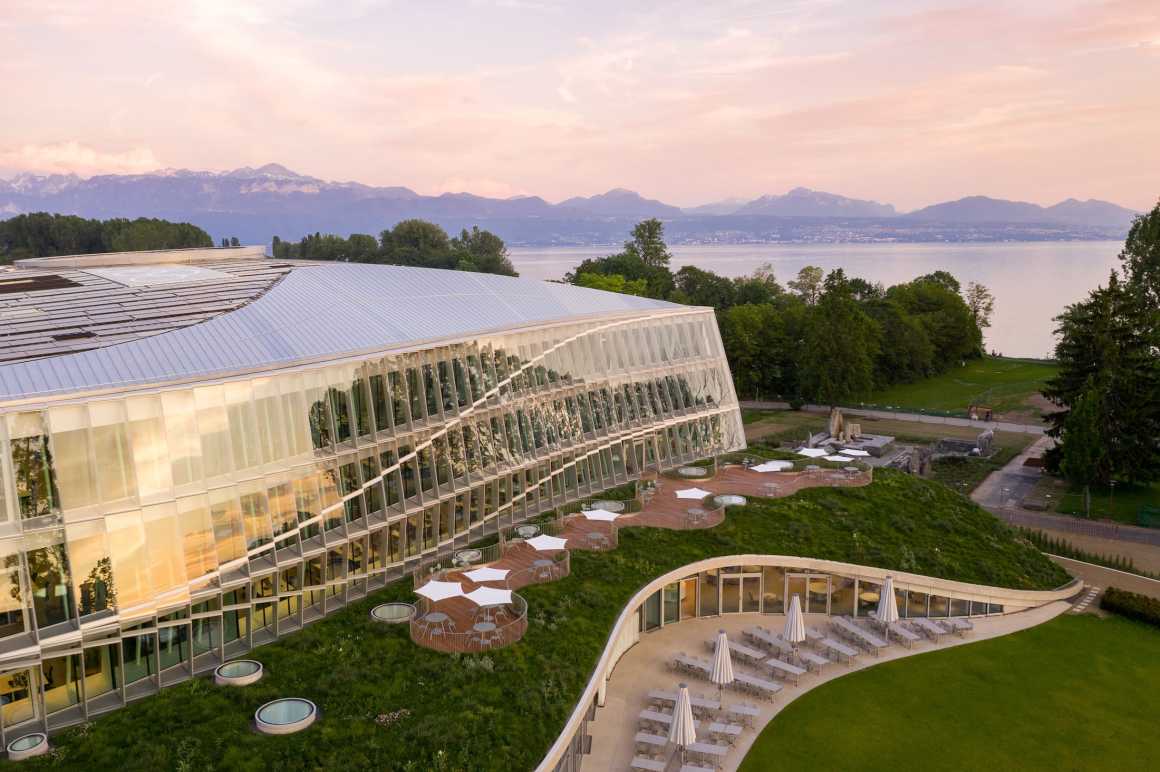
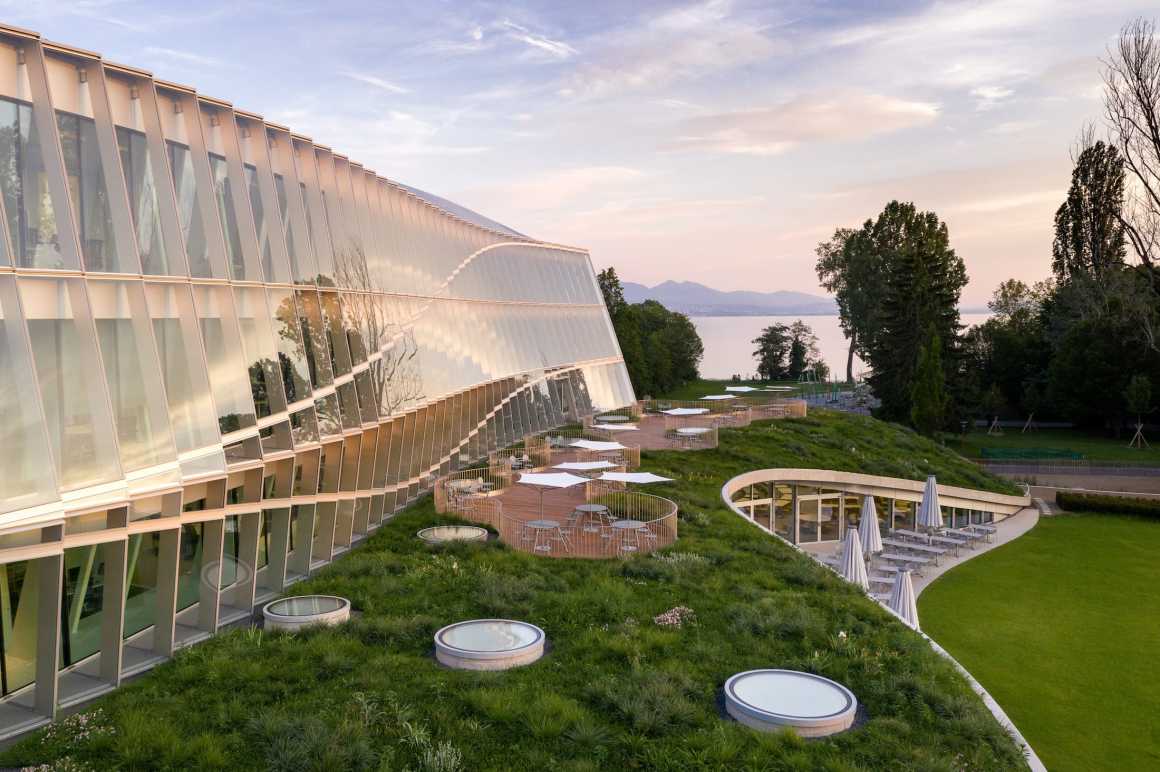
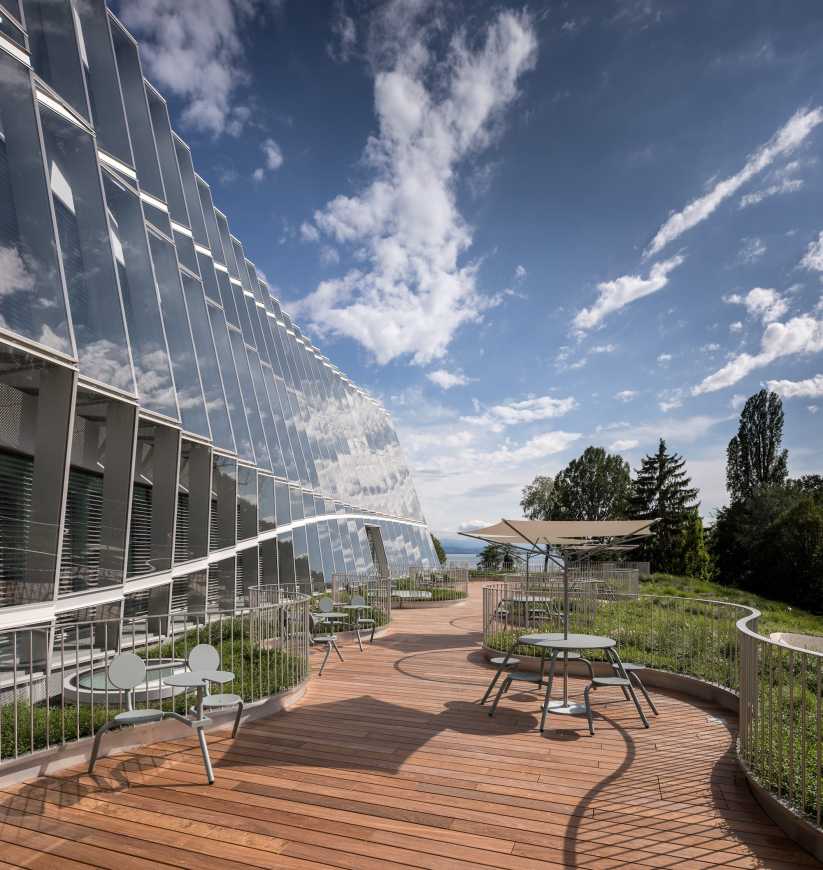
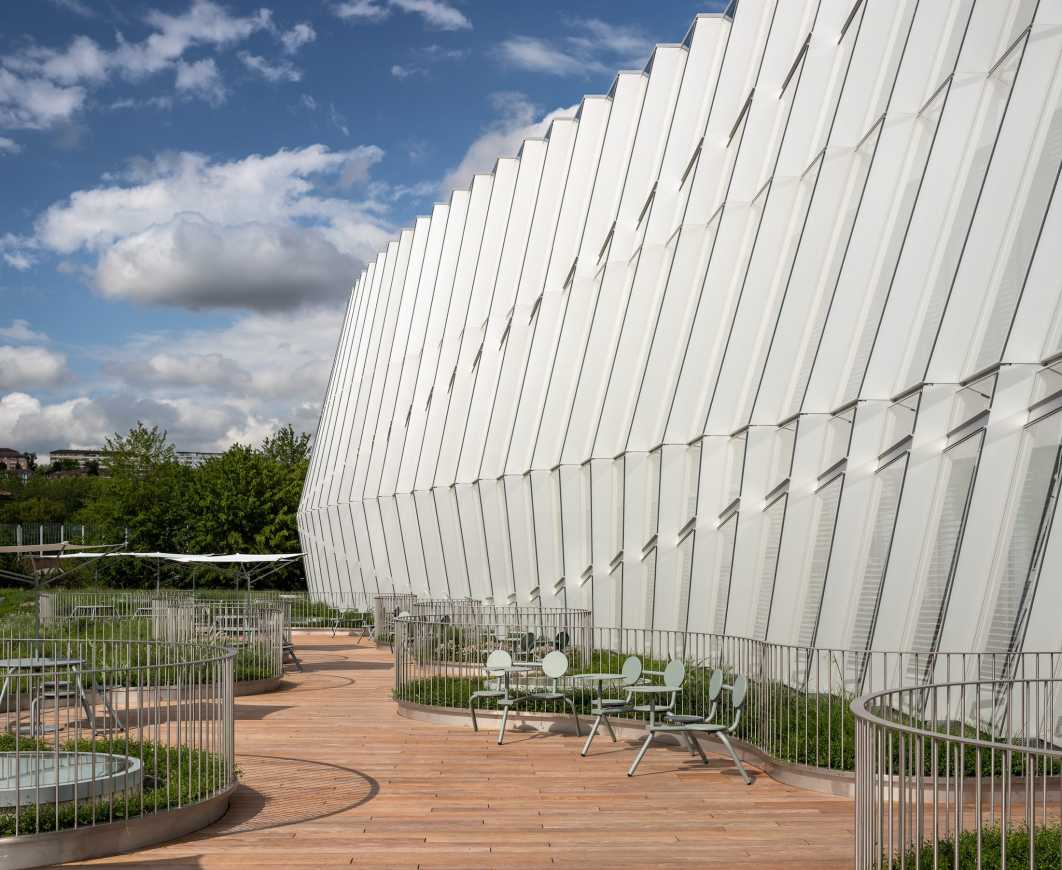
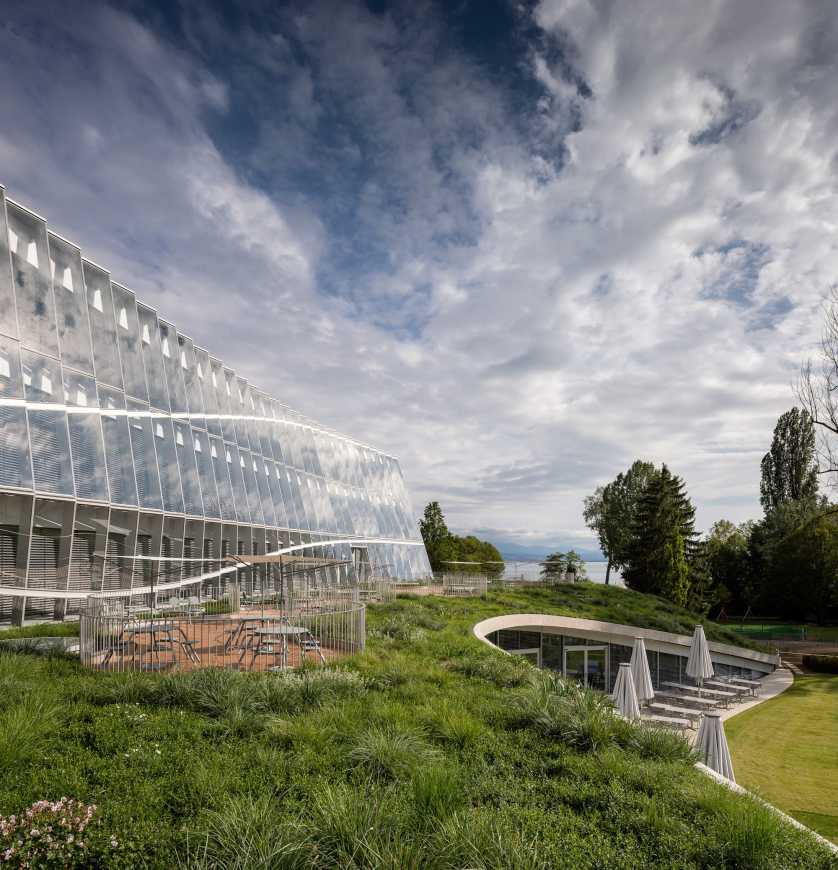
灵活性和敏捷性 Flexibility and agility
建筑立面作为3XN设计的一个标志,通过模仿运动员优雅的动作向奥林匹克精神致敬。立面的动态起伏的流线传递着运动员的运动能量,从各个角度看起来都不尽相同。在体育运动中,运动会带来最佳表现,同样,建筑围护结构的形式操作对建筑的功能也有着直接的影响。奥林匹克大厦是国际奥委会的标志和象征,但它同时也是一个繁忙的工作场所。
A hallmark of 3XN’s design, the façade pays tribute to the Olympic spirit by emulating the graceful movements of an athlete. The dynamic, undulating flow of the façade appears differently from all angles, conveying the energy of an athlete in motion. In sports, movement leads to optimized performance; likewise, the formal manipulations of the building envelope have a direct effect on the building’s functioning. Olympic House is a global icon and a symbol of the IOC, but it must also function as a busy workplace.
3XN的核心设计理念是建筑塑造行为,这是设计新的国际奥委会总部时的首要出发点。透明和流线型的设计旨在促进和鼓励员工之间的互动、沟通和知识共享。增强建筑空间的流通性将促进工作人员之间的团结协作,所以室内设计要尽可能减少结构约束:只保留4个服务核心和14根柱子支撑着建筑结构。技术室和电气室的策略性布局使得工作环境更加灵活,办公室可以轻松地在开放空间中移动,工作空间可以根据IOC工作人员的需求变化轻松地进行调整,为因战略和组织变化而高度流动的员工提供了专属的工作环境,从而达到鼓励内部协作的目的。
3XN’s central belief that architecture shapes behavior was a primary consideration while conceiving of the new IOC Headquarters. The transparency and flow of the design is intended to facilitate and encourage interaction, communication and knowledge sharing among the staff. Enhanced circulation will serve as a catalyst for collaboration and solidarity among the workforce. The interior is designed with as few structural constraints as possible: 4 service cores and 14 pillars support the structure of the building. The systematic arrangement of the technical and electrical elements enables an agile working environment, dedicated to a highly mobile workforce that adapts to strategic and organizational changes. With offices that can be easily moved through the open spaces, workspaces can be easily modified according to the ever-changing needs of the IOC staff, encouraging internal collaboration.
团结协作 Unity and collaboration
通过一个中央中庭连接所有楼层的大团结楼梯高耸入云,其设计灵感来自Baron Pierre de Coubertin的奥林匹克五环。遵循主动设计的原则,橡木楼梯及其周边定义了社会活动和运动的中心区域。楼梯是国际奥委会工作人员和利益相关者之间团结协作的视觉表现。展览空间、自助餐厅和会议室也围绕中央楼梯布置,为500名老用户带来了社区生活感。奥林匹克之家也是许多不同利益相关者,包括国际奥委会的一些商业伙伴(陶氏、丰田和松下)、可持续发展认证机构、地方当局、供应商和学者,以及国际奥委会工作人员等之间创新合作的一个独特例子。
The Unity Staircase, which references Baron Pierre de Coubertin’s Olympic Rings, soars the full height of the building and connects all floors through a central atrium. Following the principles of active design, the oak staircase and its periphery define the central area for social activity and movement. The staircase is a visual expression of the unity and collaboration between the IOC staff and stakeholders. Exhibition spaces, a cafeteria and meeting rooms are also arranged around the central staircase, promoting a sense of community for the 500 regular users. Olympic House is also a unique example of innovative collaboration between many different stakeholders, including some of the IOC’s commercial partners (Dow, Toyota and Panasonic), sustainability certification bodies, local authorities, suppliers and academics, as well as the IOC staff.
▼楼梯灵感来源 The concept of Unity Staircase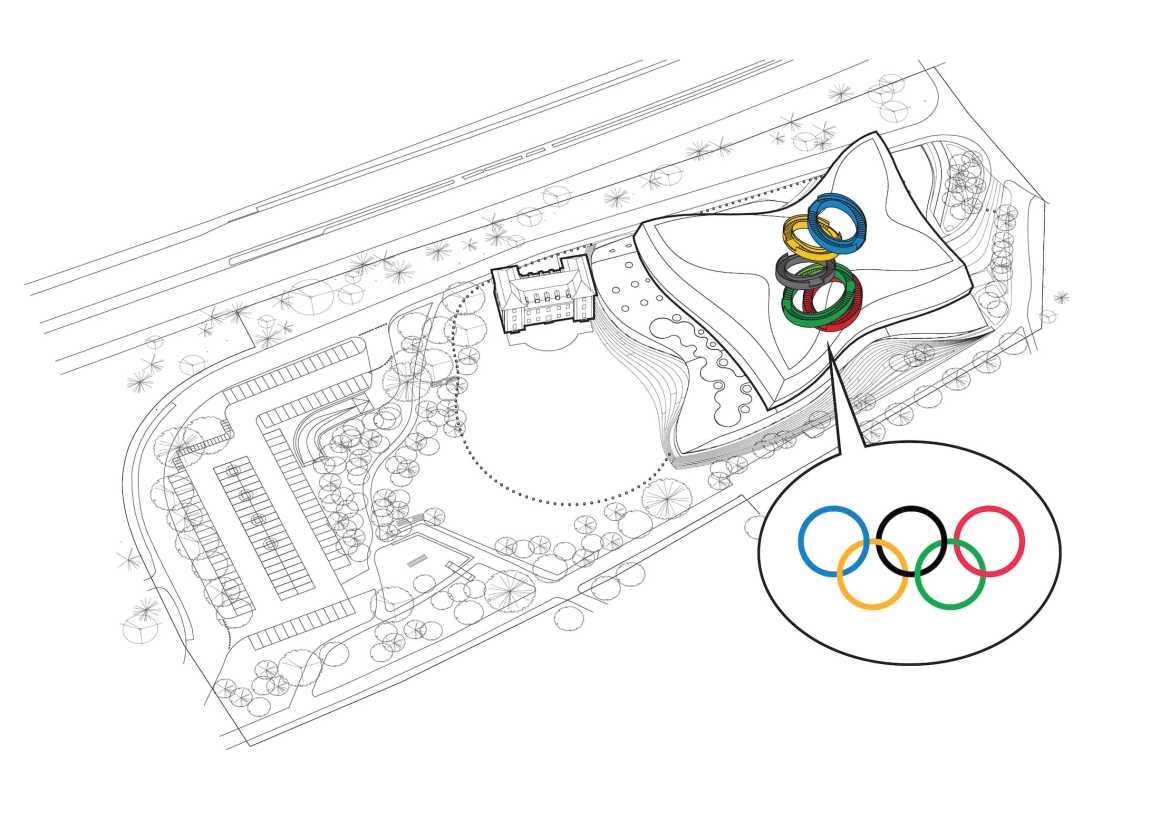 ▼楼梯剖面图 The section of Unity Staircase
▼楼梯剖面图 The section of Unity Staircase ▼高耸入云的五环楼梯 The Unity Staircase
▼高耸入云的五环楼梯 The Unity Staircase
承诺可持续性 Commitment to sustainability
3XN 不仅将国际奥委会可持续发展的承诺融入到设计和建设中,还将其融入到了奥林匹克大厦的运营理念之中。在不影响工作环境质量的情况下,通过创新功能,将建筑对环境的影响降到最小。建筑的围护结构借助气密性和内部立面的三层玻璃实现了良好的隔热效果,立面内层提供隔热,外层结构强化设计,通过集成遮阳系统保护建筑并降低附近高速公路传来的噪音。建筑围护结构专门设计成特定向内和向外的推进和流动形态,以此扩增的立面表面增加内部采光和观景视线。
The IOC’s commitment to sustainability has been integrated by 3XN not only into the design and the construction, but also through the development of operational concepts for Olympic House. Through innovative features, the building’s environmental footprint is minimized without compromising the quality of the working environment. The building’s envelope allows for excellent insulation through airtightness and the triple glazing on the internal skin facade. The inner layer of the façade provides thermal insulation while the outer layer enhances the design, protecting the building through an integrated sunscreen system and reducing noise from the nearby highway. The envelope of the building is designed specifically to push and flow inward and outward, gaining additional façade surface area for day lighting and views.
▼可持续性设计策略 Sustainability design concept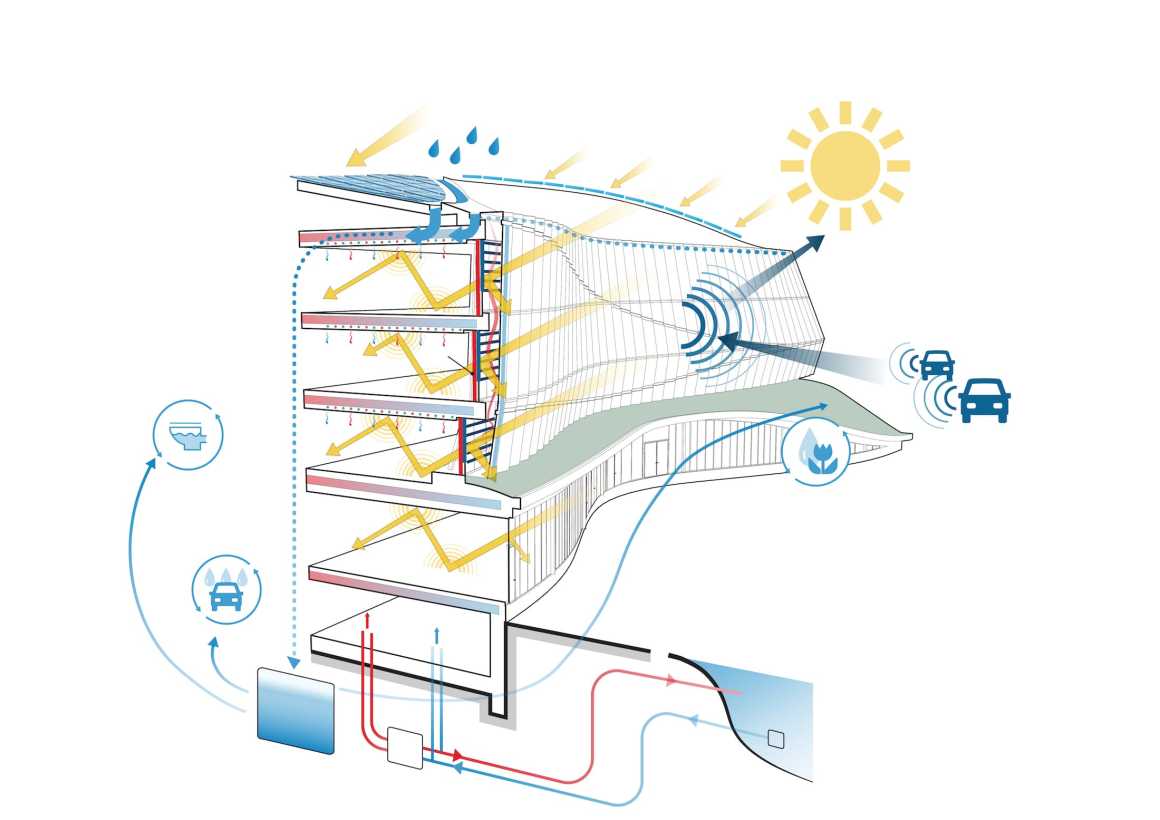
该建筑主要通过使用可再生能源、智能建筑设备、热循环系统及其围护结构保证高能源效率。节水型卫生设备和雨水收集系统极大地降低了建筑用水量,屋顶下的太阳能电池板有助于提高建筑的电力供应,另一项重要的可持续设施是利用热量交换器和热泵使用湖水来加热和冷却建筑。所有建筑材料都经过精心挑选,旨在限制污染物的排放同时确保使用者拥有最佳地室内空气质量。对前国际奥委会行政大楼的尊重性拆除也是该项目的一个重要组成部分,通过对建筑材料的再利用、选择性拆除和回收,促进了经济的循环发展。原有建筑的95%以上的材料被重复利用或回收,进一步加深了大楼的可持续性印记。新的国际奥委会总部是21世纪的一个创新范例,也是国际奥委会在洛桑根源地与本组织未来可持续性愿景之间的一座桥梁。
The building will be mainly supplied with renewable energy, while smart building features, heat recovery systems and its envelope ensure a high energy efficiency. Water- efficient sanitary equipment and rainwater capture significantly reduce the building’s water consumption. Solar panels placed to underline the roof design contribute to the building’s electricity supply. Another important sustainability feature is the use of lake water through heat exchangers and heat pumps for heating and cooling the building. The materials were carefully chosen with the intention of limiting pollutant emissions and ensuring the best indoor air quality for the user’s comfort. The respectful deconstruction of the former IOC administration buildings was a significant element of the project, contributing to a circular economy through the reuse, selective demolition and recycling of construction materials. Over 95 percent of the former administrative building’s materials were reused or recycled, furthering the building’s sustainability imprint. Olympic House serves as a bridge between the roots of the IOC in Lausanne and the vision of the organization for a sustainable future. The new IOC Headquarters is an innovative example of a 21st century.
▼首层平面图 The ground floor plan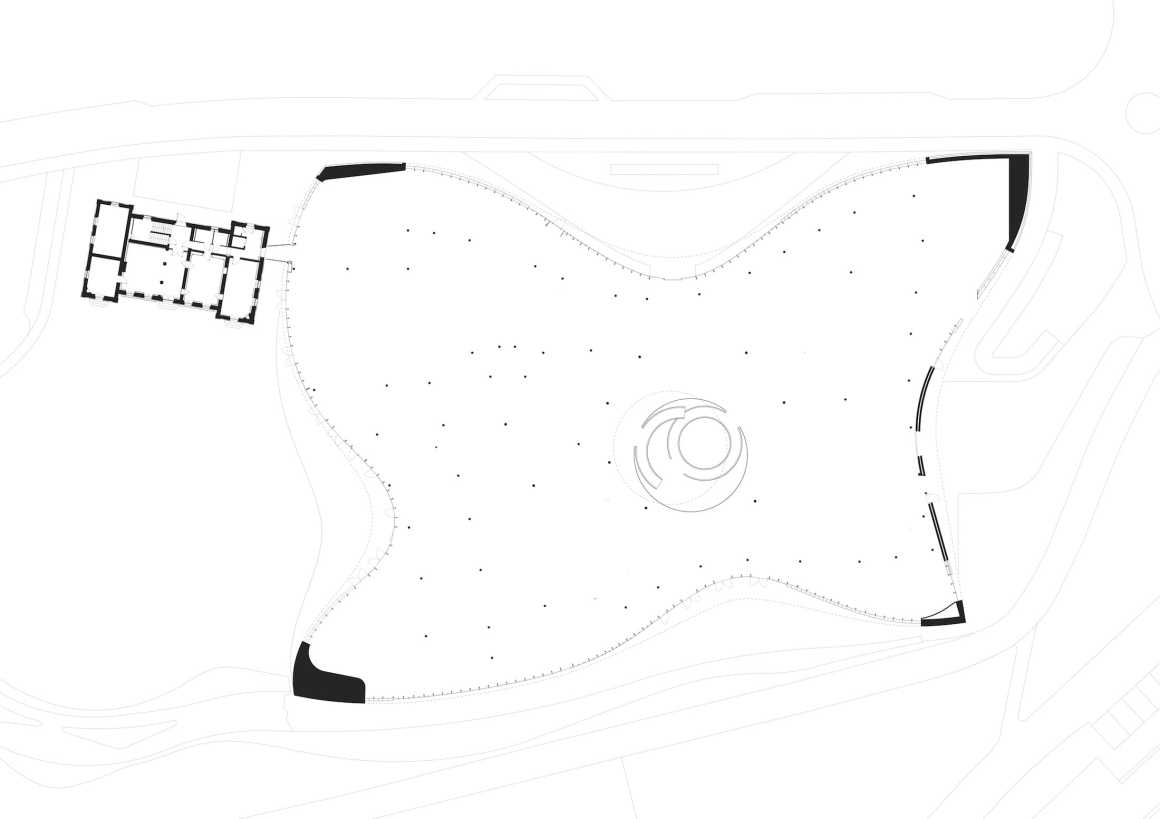 ▼屋顶平面图 The roof plan
▼屋顶平面图 The roof plan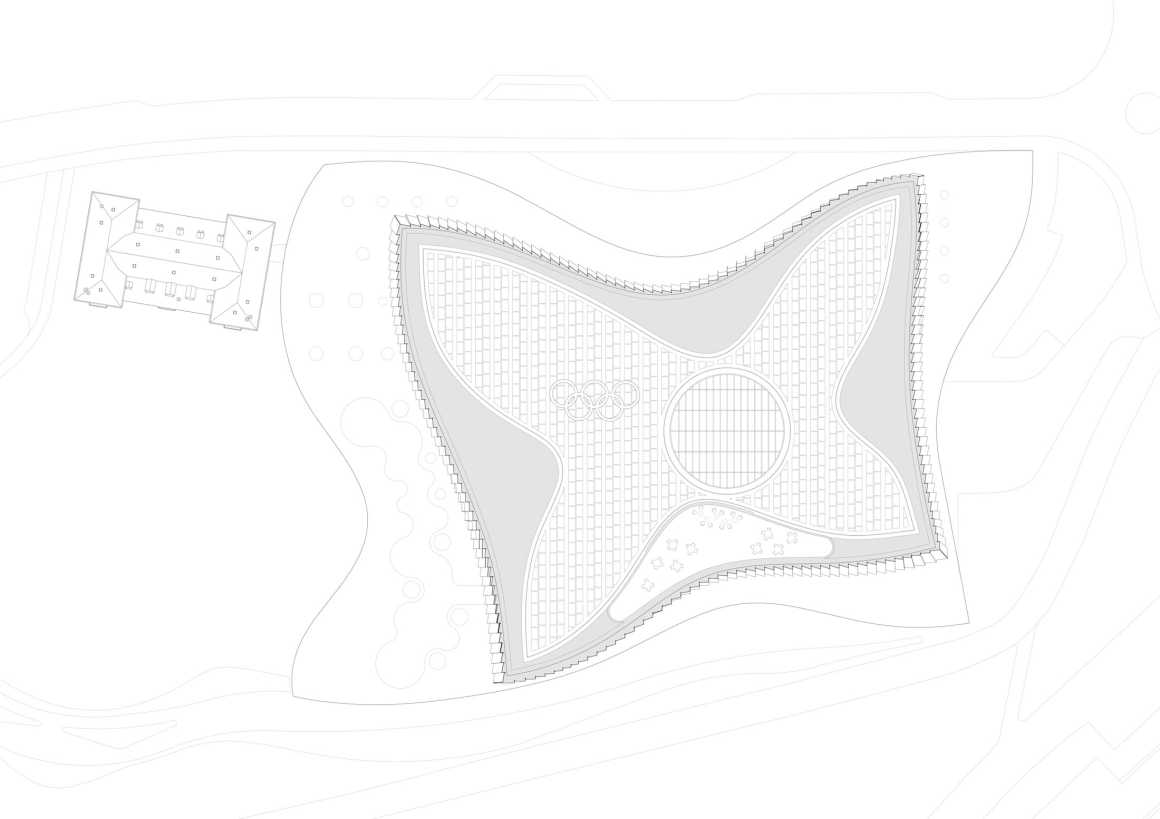 ▼建筑立面图 Elevation
▼建筑立面图 Elevation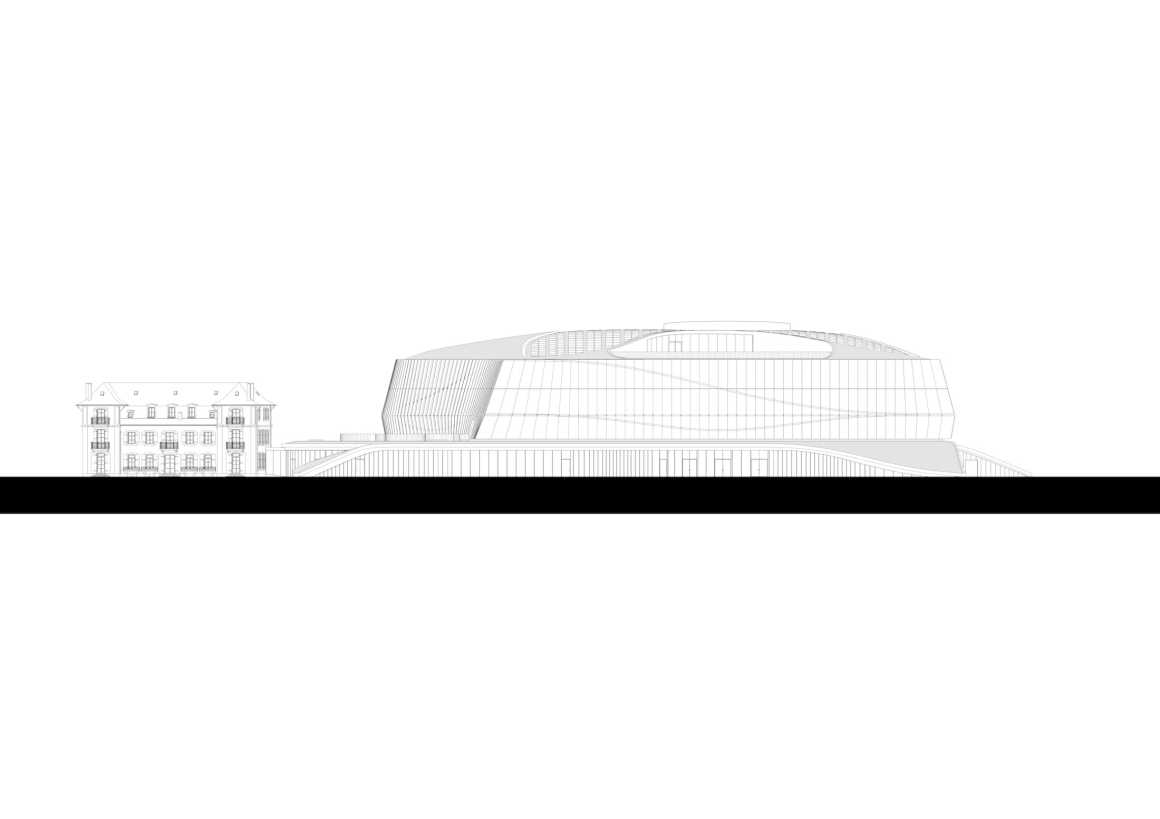 ▼建筑剖面图 Sections
▼建筑剖面图 Sections
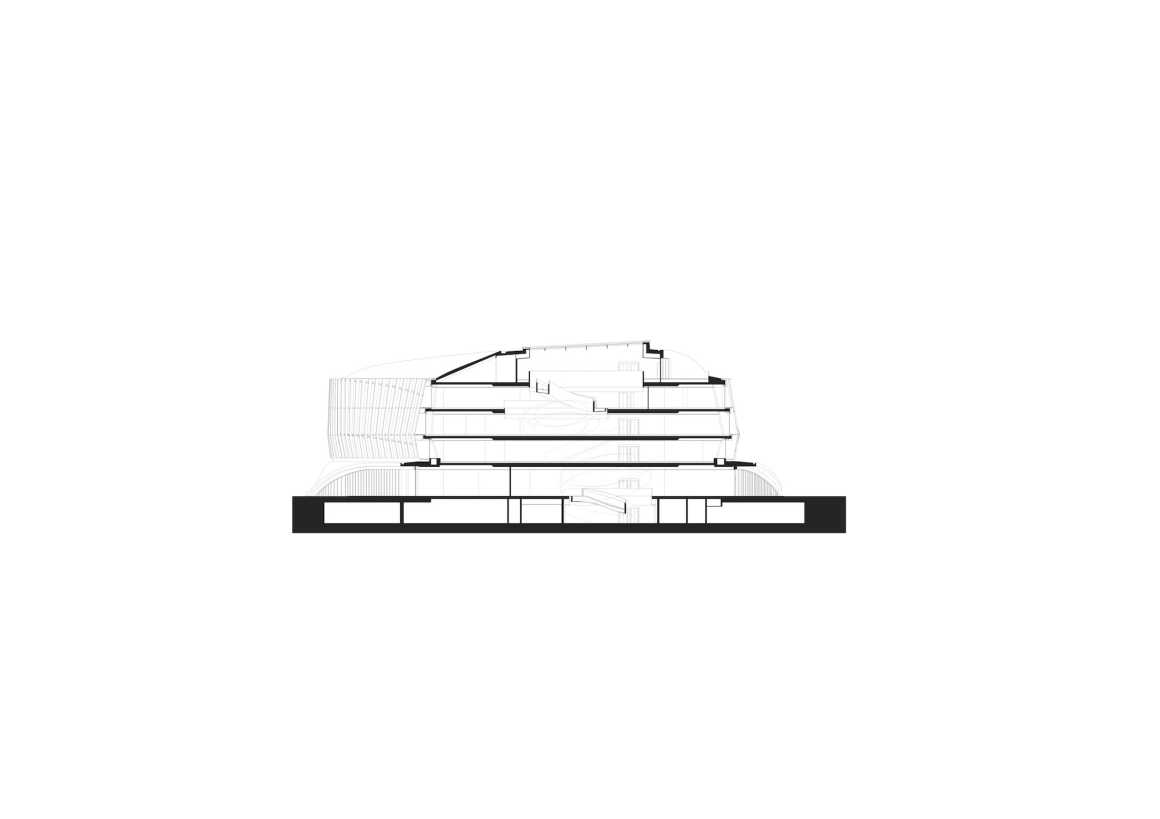
委托人:国际奥委会
项目指导:Marie Sallois
项目主创:Thierry Tribolet,负责服务的bâtiments Nicolas Rogemond
建筑设计:3XN Architects -丹麦
当地建筑公司:Itten + Brechbuhl
土木工程:Ingeni
电气工程:MAB
采暖、通风和空调(HVAC)工程:Weinmann
室内设计:RBS Group – 意大利
平面设计:Base design
奥林匹克体验:Studio Banana 和 i-Art
客户项目助理:Irbis consulting
规划设计:IMMA
可持续发展(LEED):Thema Verde
景观设计:Husler & Associes
主要工作:Marti and Sotrag (consortium)
立面:Frener Reifer(办公楼层);Roschmann(一楼)
建筑照明设计:Jesper Kongshaug
厨房专家:SCHÉMA-TEC
摄影师:Adam Mørk, Copenhagen Lucas Delachaux, Lausanne
效果图:Forbes Massie,3XN
楼层:6层(奥林匹克大厦)、3层(城堡)
总建筑面积:135000平方米(奥林匹克大厦),3900平方米(城堡),场地面积:313390平方米
建筑面积:5950平方米(奥林匹克大厦),325平方米(城堡)
规模:2.2万平方米,850平方米(Chateau)
停车:汽车203辆,摩托车25辆
Client: The International Olympic Committee
Directrice de programme: Marie Sallois
Chef de programme: Thierry Tribolet, Responsable service des bâtiments Nicolas Rogemond
Architects: 3XN – Denmark
Local architects: Itten+Brechbühl
Civil engineer: Ingeni
Electrical engineer: MAB
Heating, Ventilation, and Air Conditioning (HVAC) engineer: Weinmann
Interior design: RBS Group – Italy
Graphic design: Base design
Olympic experience: Studio Banana and i-Art
Assistance to Project Owner: Irbis consulting
Planning expert: IMMA
Sustainability experts (LEED): Thema Verde
Landscape Architect: Hüsler & Associés
Major works: Marti and Sotrag (consortium)
Façade: Frener Reifer (Office Floors) Roschmann (Ground Floor)
Architectural lighting design: Jesper Kongshaug
Kitchen specialist: SCHÉMA-TEC
Photographers: Adam Mørk, Copenhagen Lucas Delachaux, Lausanne
Renderings: Forbes Massie, 3XN
Floors: 6 (Olympic House), 3 (Château)
Volume total SIA: 135’000 m3 (Olympic House) 3’900 m3 (Château) Site: 31’390 m2
Building Surface: 5’950 m2 (Olympic House), 325 m2 (Château)
Size: 22’000 m2, 850 m2 (Château)
Parking: 203 for cars, 25 motorcycles
更多 Read more about: 3XN Architects




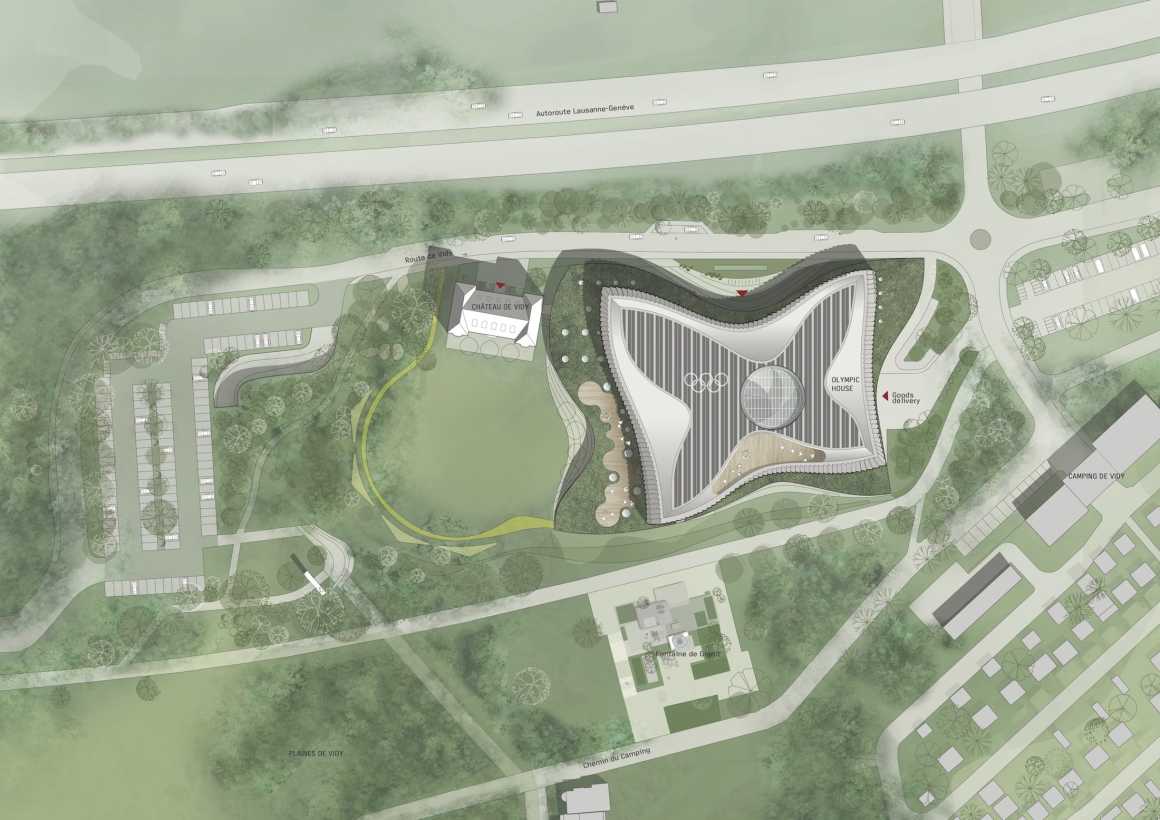
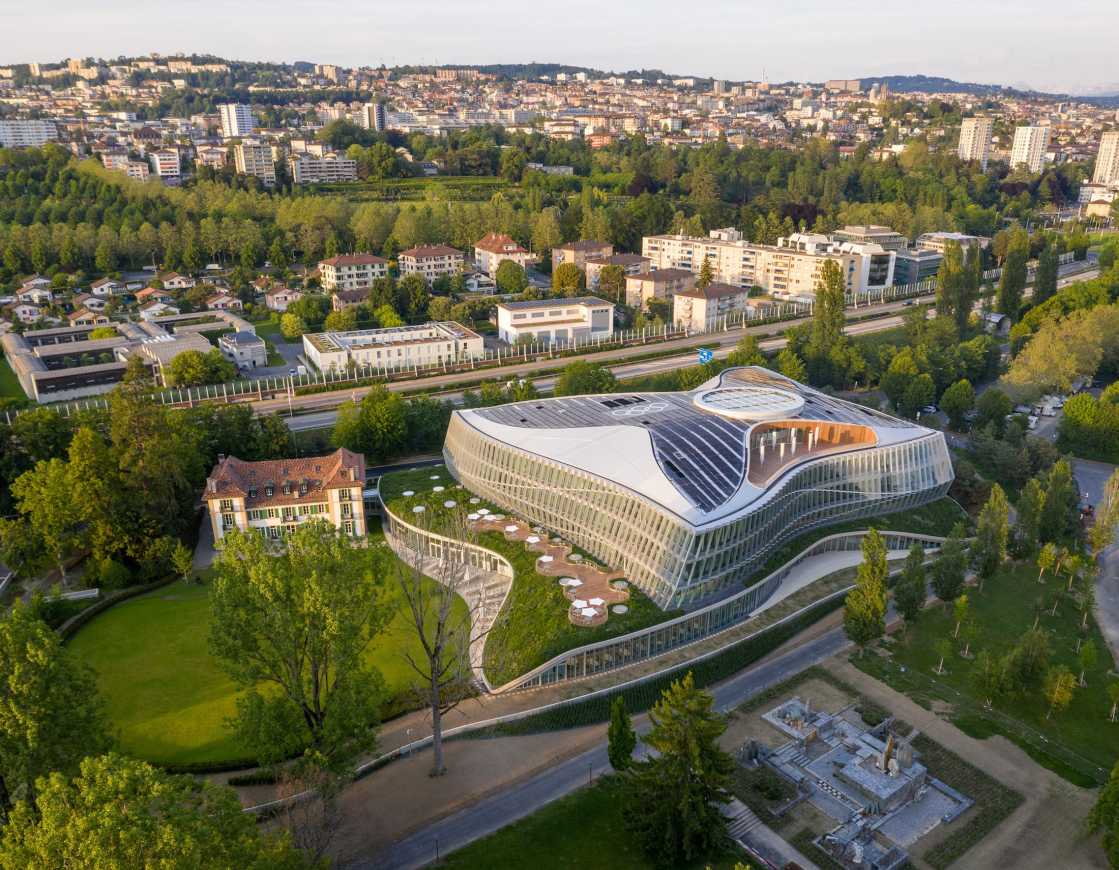
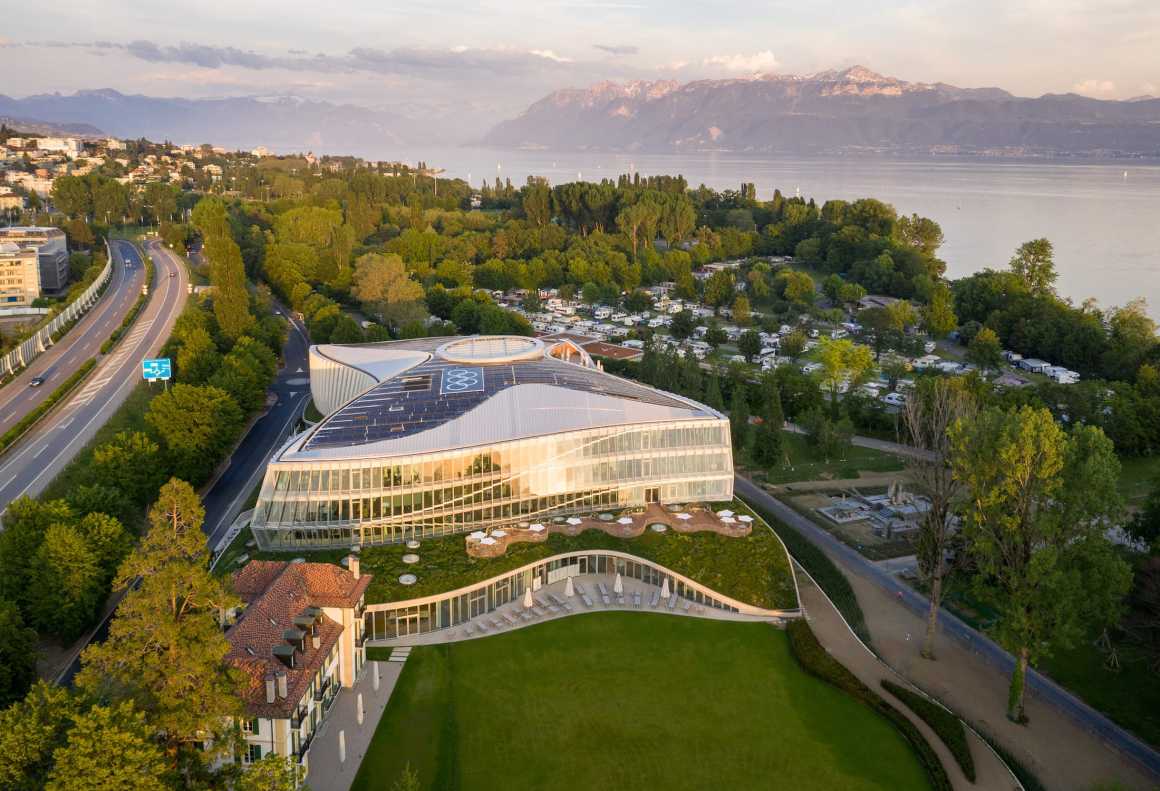

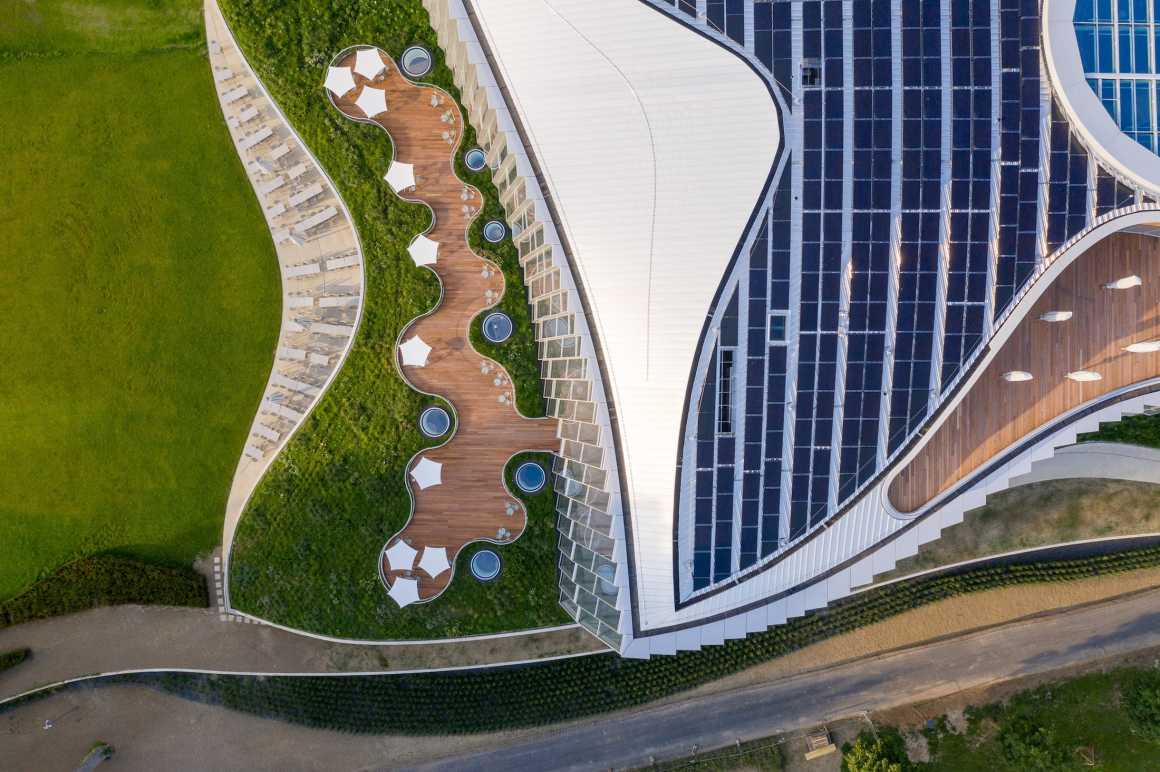


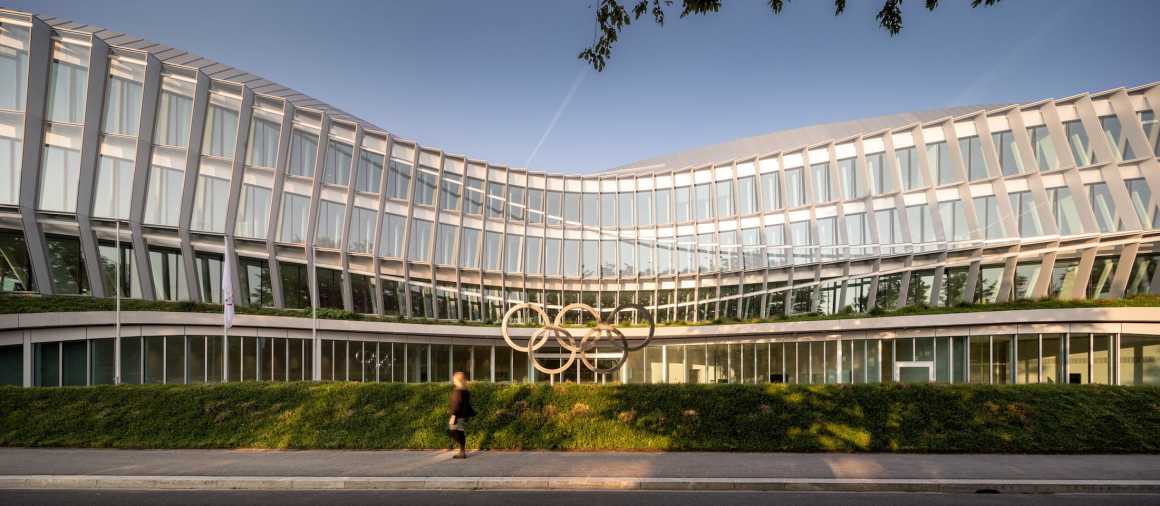

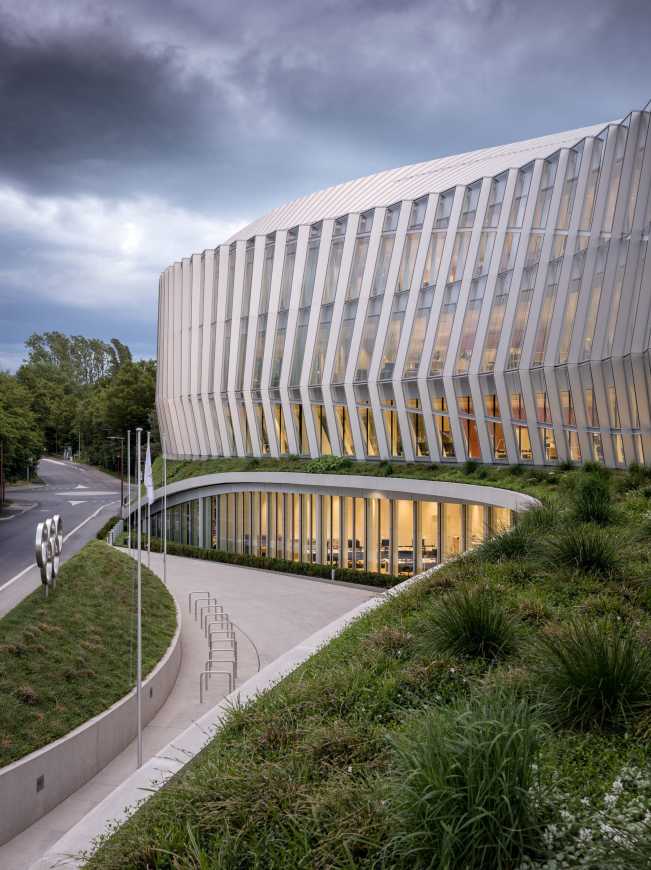
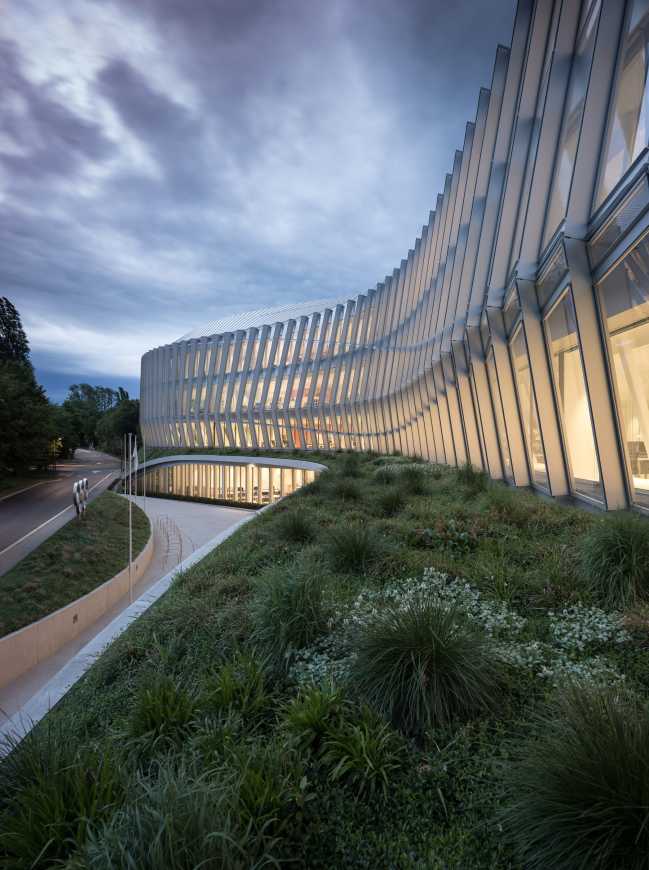
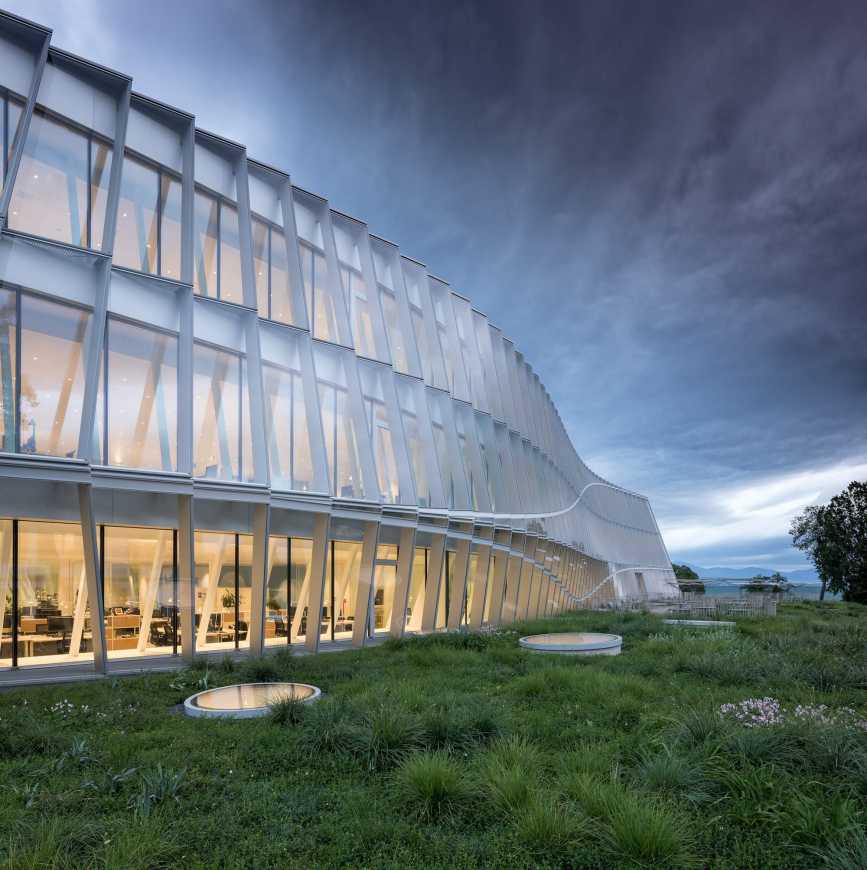
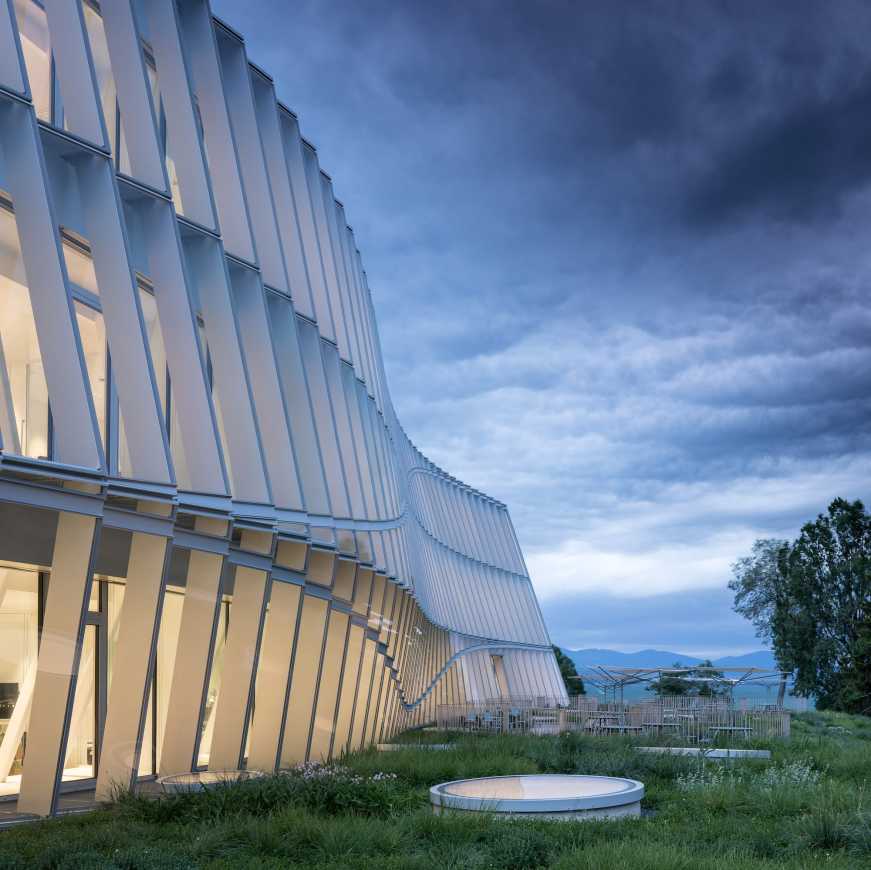
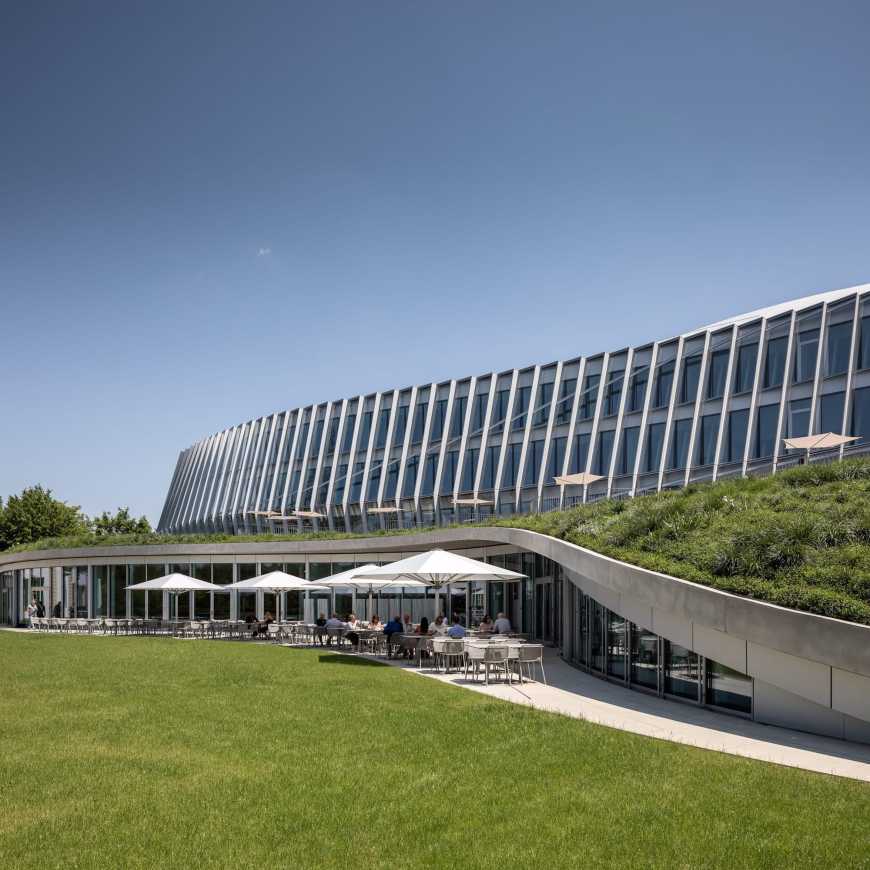



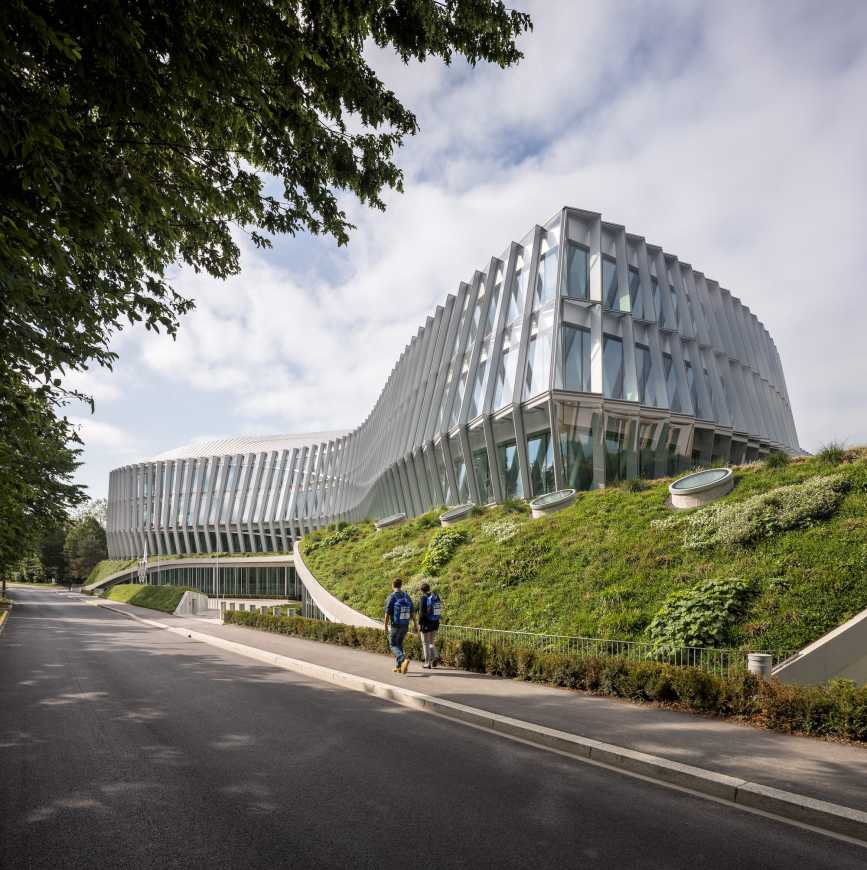


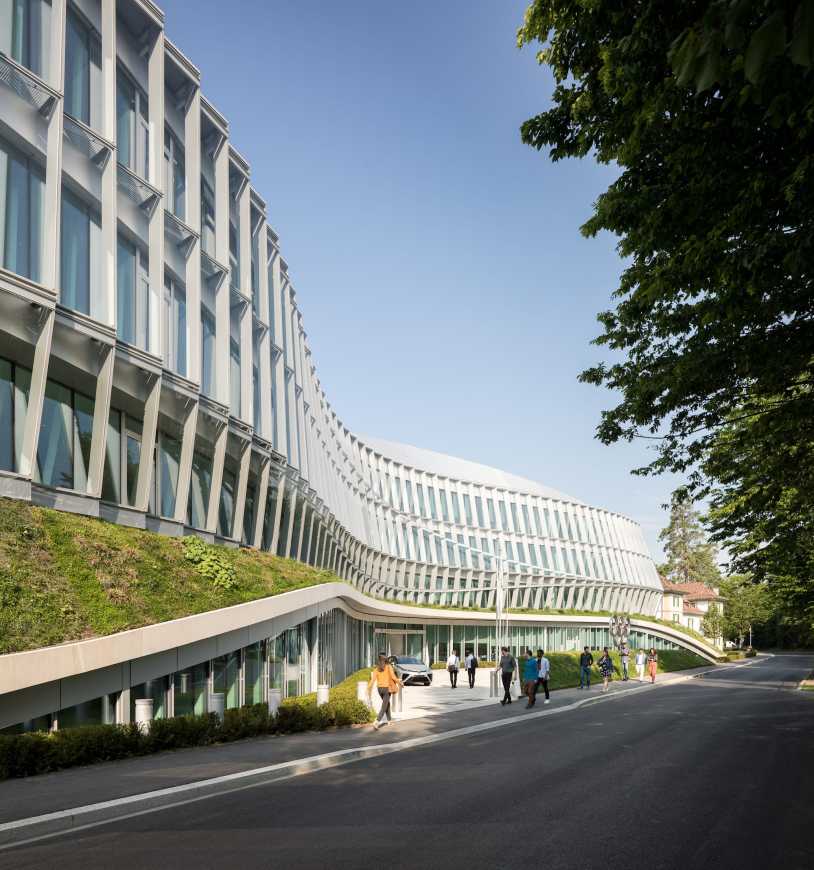
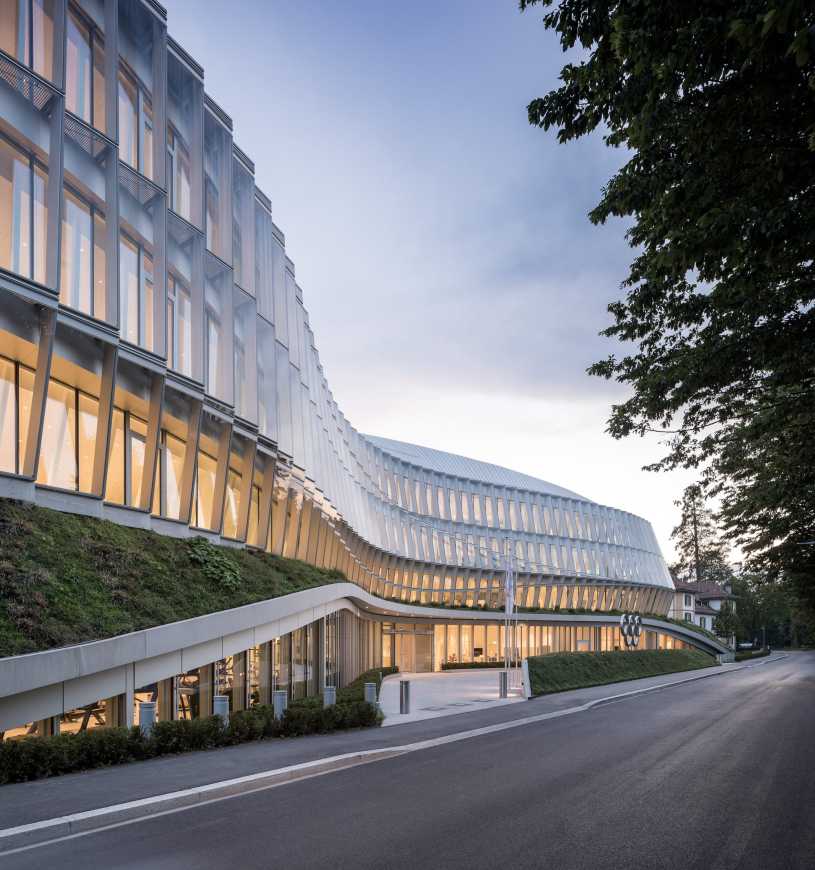

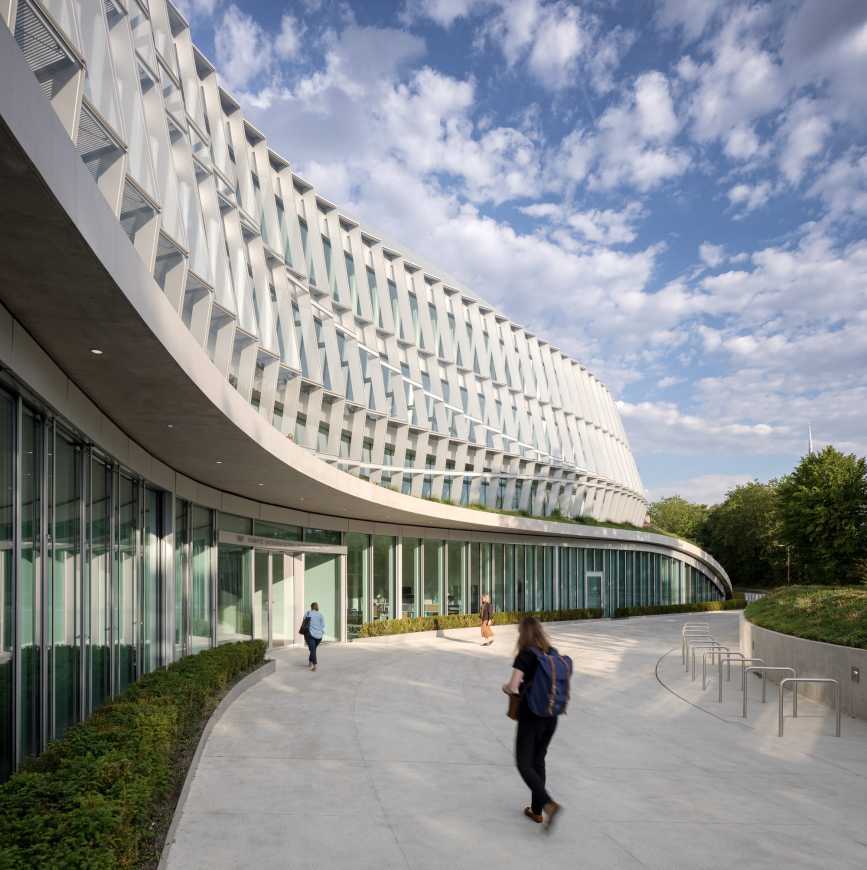

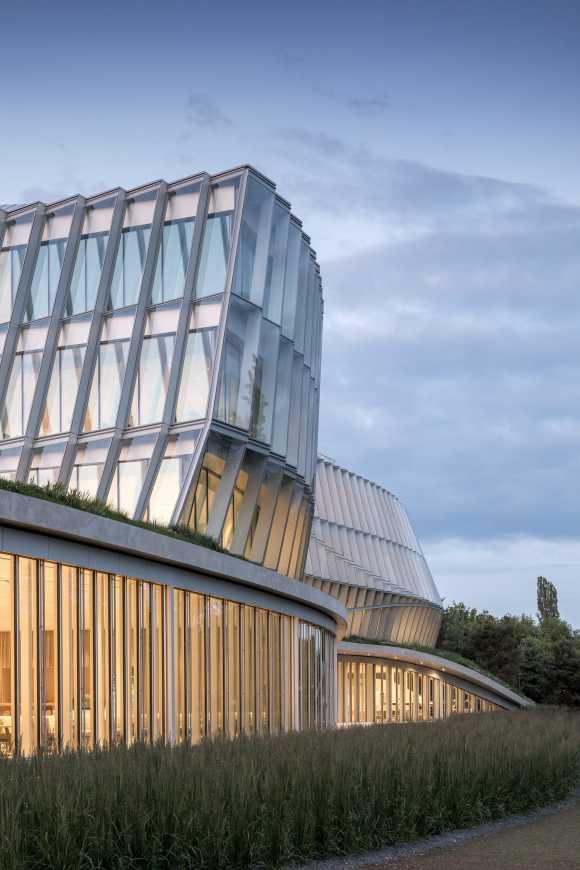
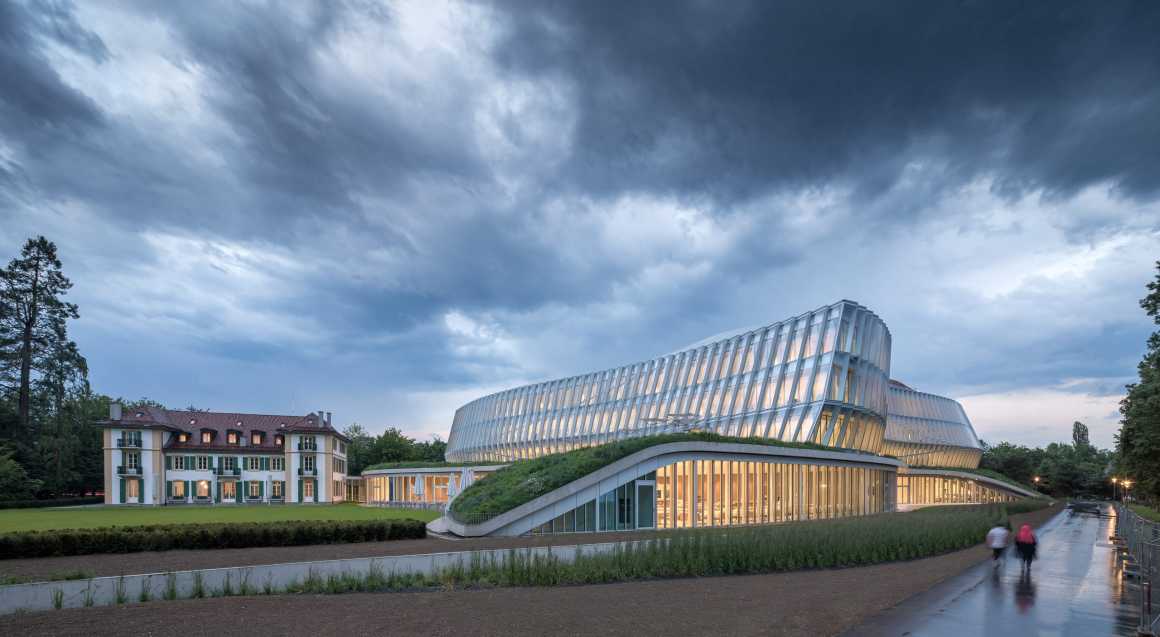
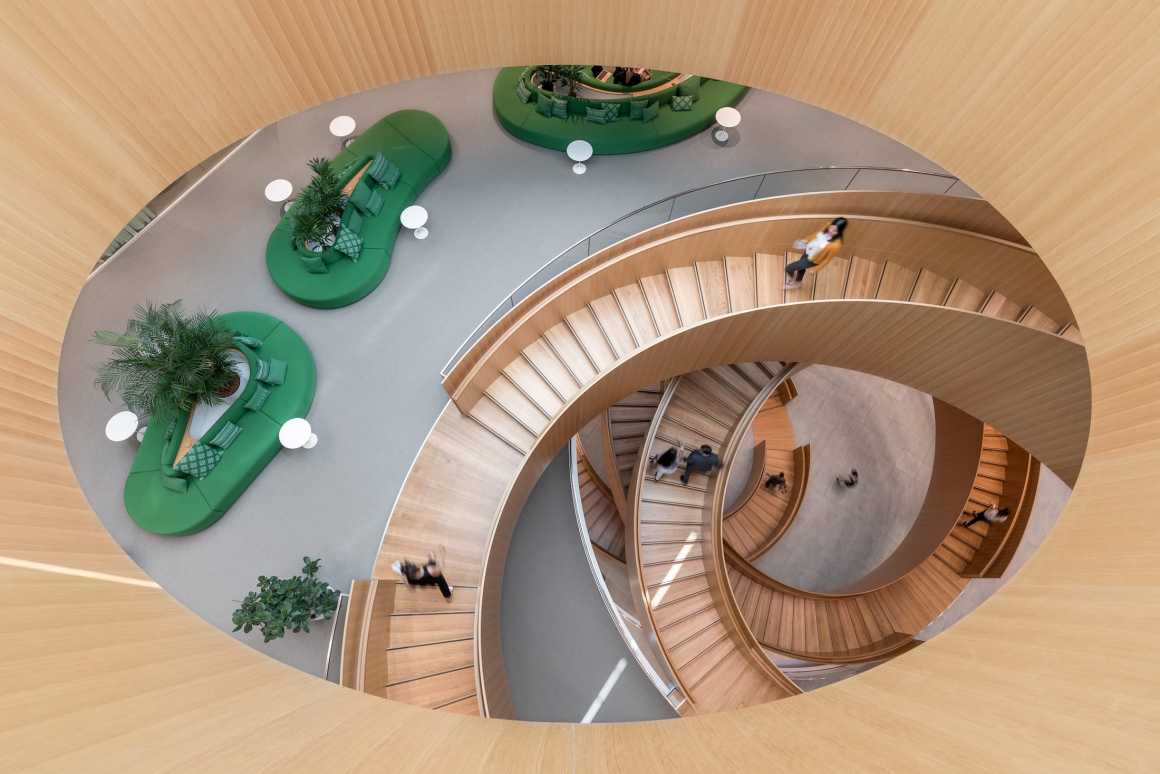

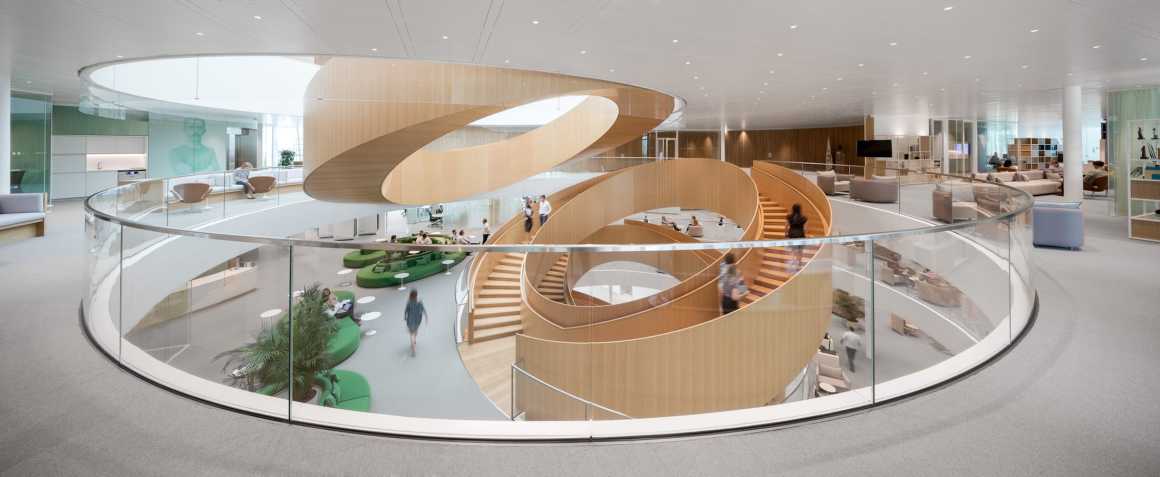
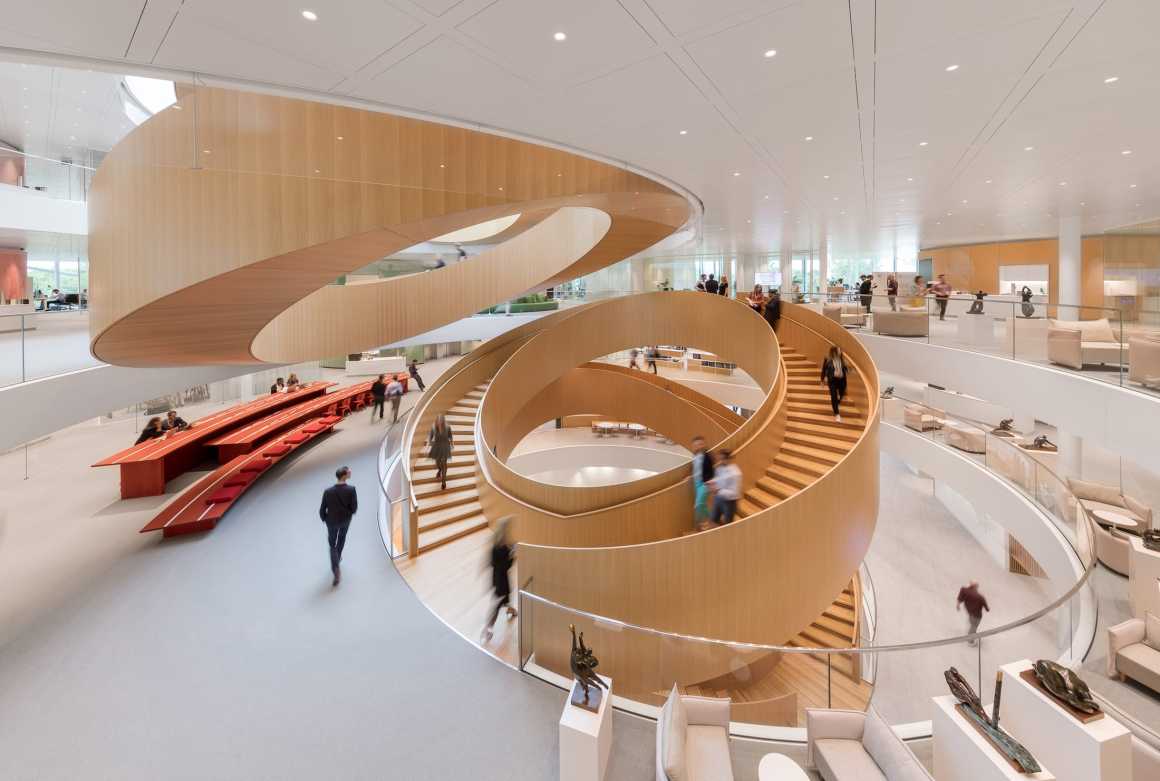

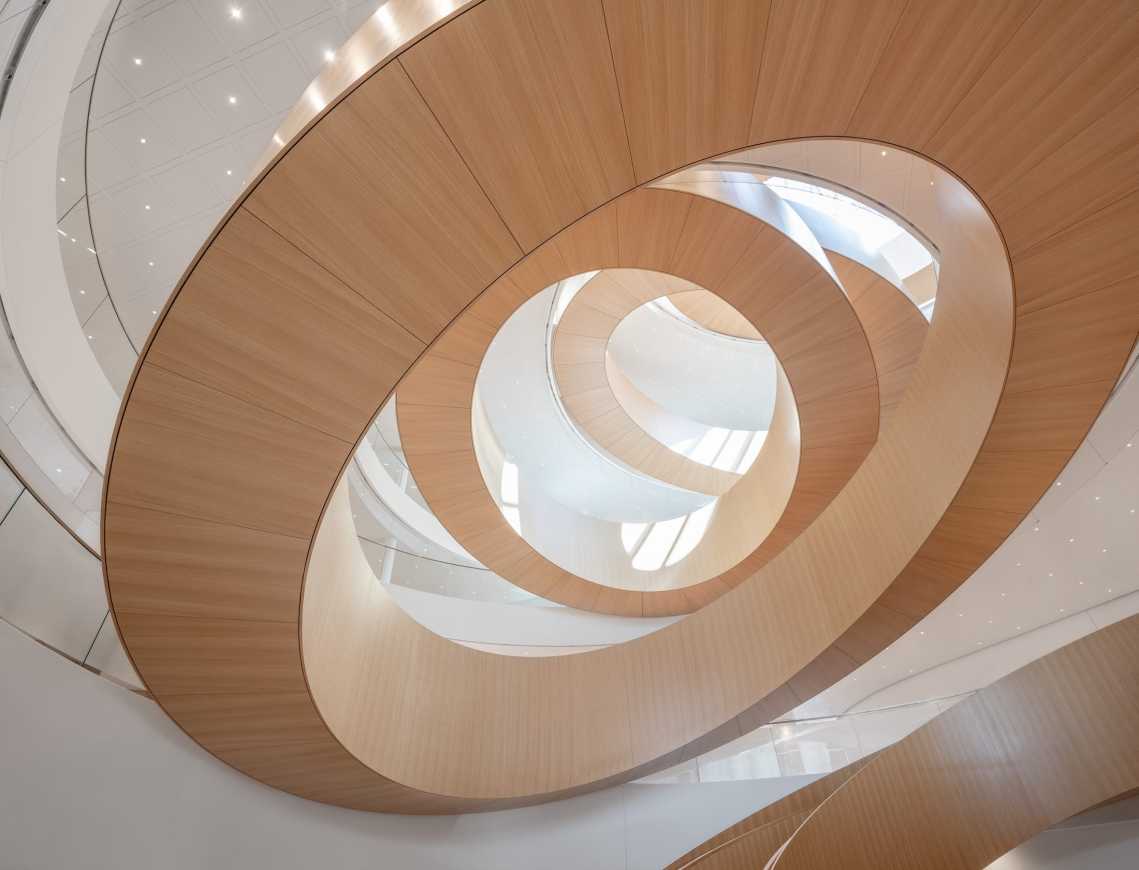

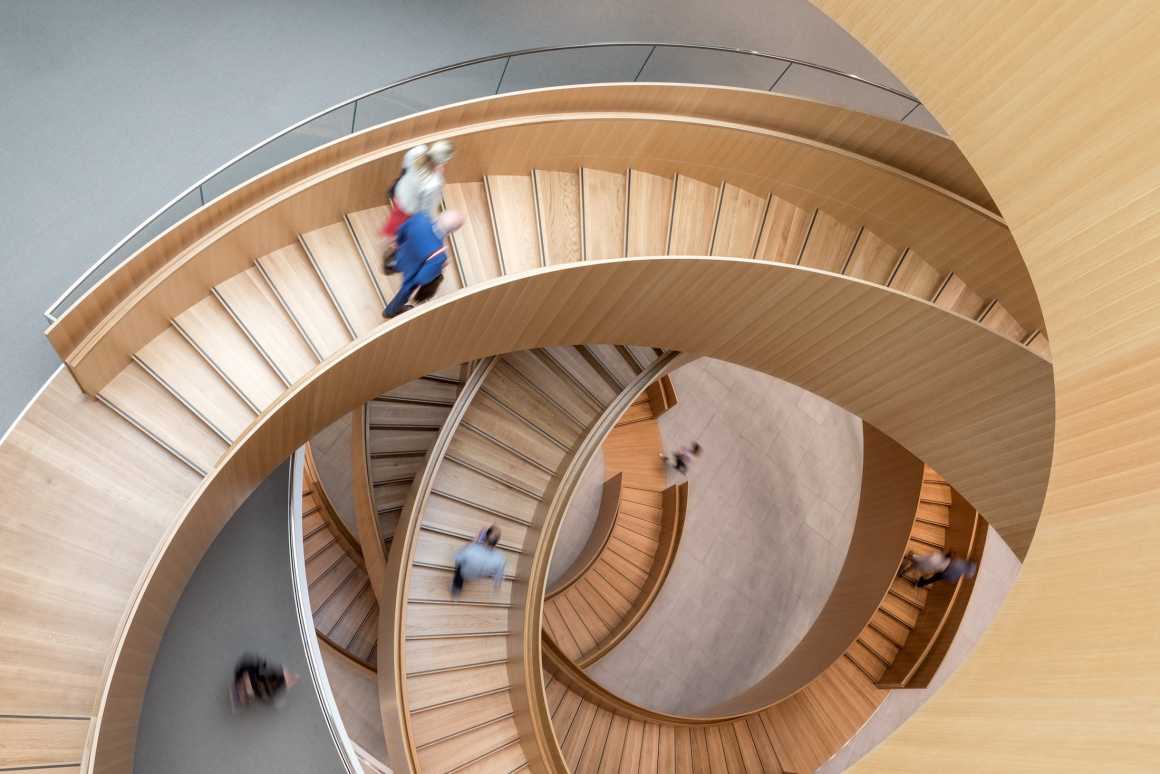

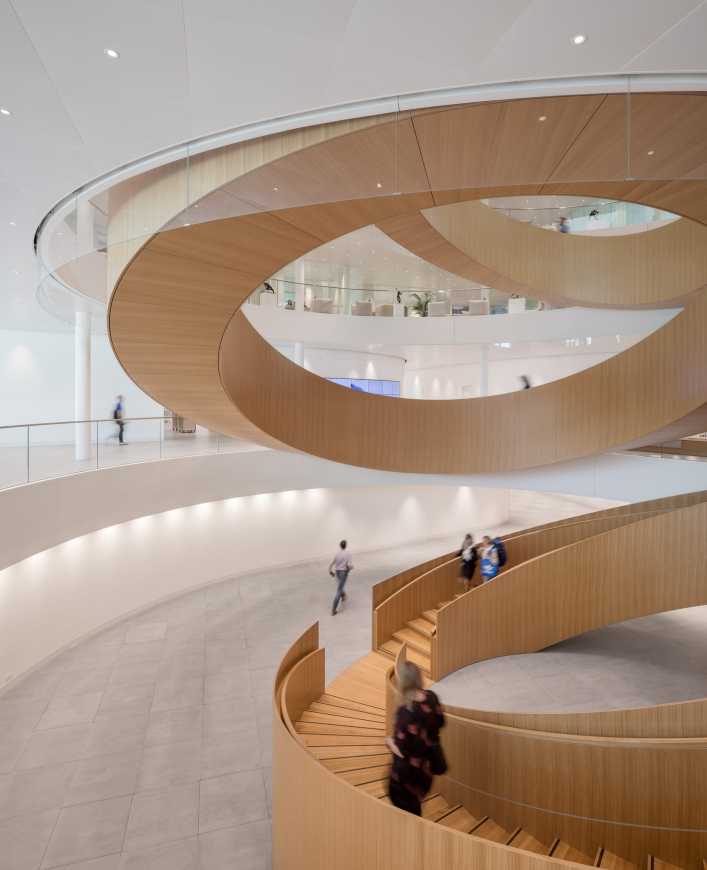
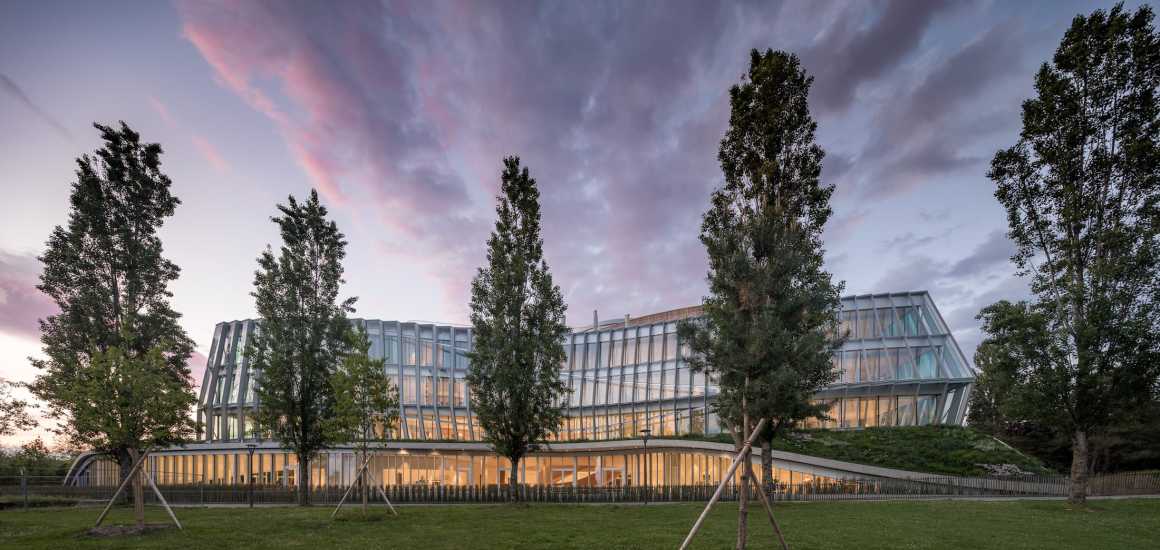
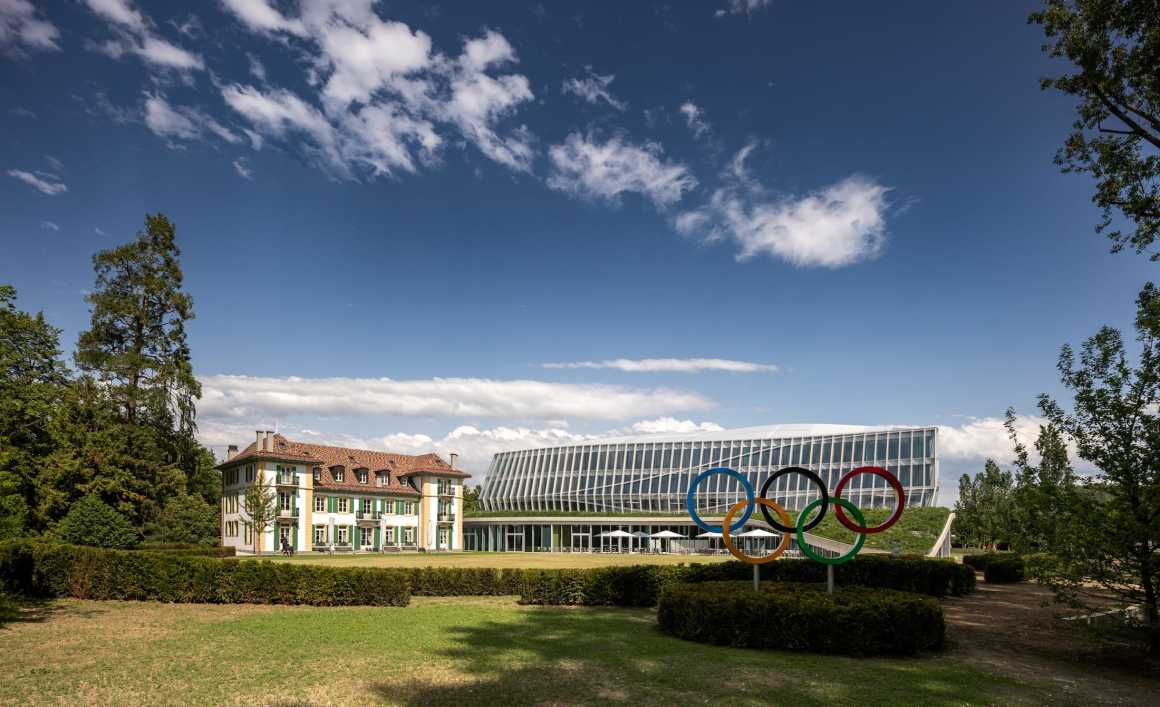



0 Comments